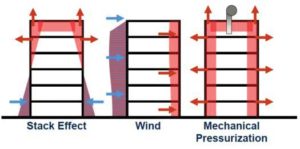Using roofing parapets for airtight roofs

By Paul Johannesson
Air leakage, despite popular notion, is not just a wall thing—it is a whole building thing. Air can leak into and out of a building on all six sides and failing to address this fact in design and detailing can have negative effects on the performance and life cycle of buildings.
Leaks in foundations and floors can allow water, radon gas, and volatile organic compounds (VOCs) to enter. Leaks in walls and windows can draw water into the assemblies where it can cause damage to building materials and cause mould growth. Uncontrolled air leakage can reduce occupant comfort while negatively affecting air quality and energy efficiency.
Air leakage in roofing assemblies can ultimately result in catastrophic roof failures affecting the building, its contents, and inhabitants. Therefore, it is paramount to pay attention and become familiar with all the environmental factors affecting the built environment.
The built environment
The built environment exists to separate and protect beings and property from the extremes of the outside world. It creates separation from other people, weather events, general climate conditions, solar radiation and sound. Some examples of the built environment include neighbourhoods, houses, workplaces, schools, shops, parks, playgrounds, etc.
The challenge in separating these environments is that although occupants mostly want separation, they also want connection and sometimes at the same time. This explains the need for windows and balconies in buildings. Excellence in architecture requires this balance, but it comes at a price. This price comes in the form of balancing the esthetics and human elements with the hard facts of engineering a separation that works in all conditions.
There is where building science is applied—which is the scientific knowledge and experience that focuses on the analysis and control of: water, air, heat, and radiation on the built-environment. Professionally applied building science provides predictive capability to assist in mitigating the risks associated with the building envelope, while optimizing the life cycle and performance of the building components and its assemblies.
The building envelope can be imagined as a balloon that envelopes all sides of the building. Like a blown-up balloon, it separates or controls in part: bulk water, air pressure, water vapour, temperature (although briefly), and when haphazardly sealed or penetrated, it fails to perform. This may seem like an oversimplification of the building envelope, but this “keep it simple” approach has never been more important when it comes to building assemblies.

Poorly designed and constructed building envelopes are inefficient and uncomfortable, and can lead to premature material and assembly deterioration. The failures associated with building envelope will be in direct correlation with the work the envelope is expected to perform. Therefore, it is important to understand the work the envelope does and for that, professionals must consider the loads present in the environment (Figure 1).
Understanding the loads
When considering how air acts on buildings, it is important to understand the sources of air pressure: wind effect, stack effect, and mechanical effect.


